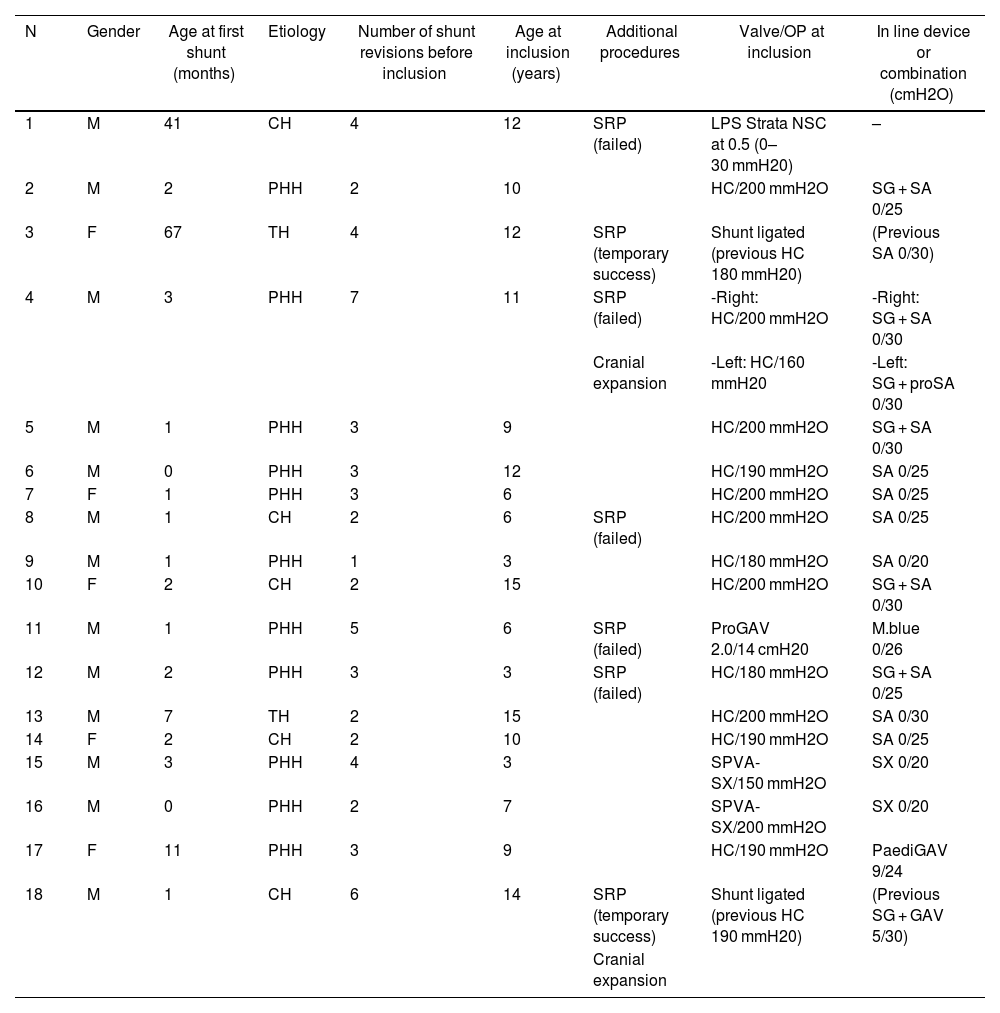Shunt overdrainage is one of the long-term complications associated with ventriculoperitoneal shunts. Treatment of refractory cases may require further upgrading of both the valve opening pressure and antisiphon device. The aim of this paper is to describe the results of this combination in a selected group of patients.
MethodsRetrospective cohort study that included 18 pediatric patients between 2003–2022. Previous shunts were exchanged for the combination of a SOPHYSA Polaris® SPVA-300 valve and upgraded fixed or adjustable antigravitatory devices. The following variables were collected: etiology of the hydrocephalus, age at first shunt and type of valve, number of shunt revisions, other surgical procedures, age at inclusion, clinical and radiological outcomes, and follow-up time. A descriptive analysis was done with means, medians and ranges for quantitative variables; percentages and frequencies for the analysis of qualitative data.
ResultsThe median age at first shunt was two months (0–67). The mean number of shunt revisions before inclusion was three. Shunt removal was attempted in seven patients without success; temporary success was observed in two patients who underwent ETV. Two patients had previous cranial expansions. The mean age at inclusion was 9.1 years (2.7–15.2). After the shunt system was exchanged and upgraded, clinical improvement was observed in 94.4% (17/18) of patients, and radiological improvement was observed in 83.3% (15/18) of patients. The median follow-up was 21 months.
ConclusionsBefore considering more invasive therapeutic measures, shunt system optimization by the combination of very high-pressure valves and upgraded in-line antisiphon devices is a valid and safe strategy for refractory symptomatic shunt overdrainage.
El sobredrenaje valvular es una de las complicaciones a largo plazo asociadas con las derivaciones ventriculo-peritoneales. El tratamiento de los casos refractarios puede requerir una optimización tanto de la presión de apertura de la válvula como del dispositivo antisifón. El objetivo de este trabajo es describir los resultados de esta combinación en un grupo seleccionado de pacientes.
MétodosEstudio de cohorte retrospectivo que incluyó a 18 pacientes pediátricos entre 2003 y 2022. Las derivaciones previas se cambiaron por la combinación de una válvula SOPHYSA Polaris® SPVA-300 y dispositivos antigravitatorios fijos o programables optimizados. Se recogieron las siguientes variables: etiología de la hidrocefalia, edad de la primera derivación y tipo de válvula, número de revisiones quirúrgicas, otros procedimientos quirúrgicos, edad en la inclusión del estudio, resultados clínicos y radiológicos y tiempo de seguimiento. Se realizó un análisis descriptivo utilizando medias, medianas y rangos para el análisis de las variables cuantitativas; porcentajes y frecuencias para el análisis de datos cualitativos.
ResultadosLa mediana de edad en la primera derivación fue de dos meses (0–67). El número medio de revisiones quirúrgicas antes de la inclusión fue de tres. Se intentó un protocolo de independencia valvular en siete pacientes sin éxito; se observó un éxito temporal en dos pacientes que se sometieron a ventriculostomia endoscópica. Dos pacientes tenían expansiones craneales previas. La edad media en el momento de la inclusión fue de 9,1 años (2,7–15,2). Después de que se cambiara y optimizara el sistema valvular, se observó una mejoría clínica en el 94,4% (17/18) de los pacientes y una mejoría radiológica en el 83,3% (15/18) de los pacientes. La mediana de seguimiento fue de 21 meses.
ConclusionesAntes de considerar medidas terapéuticas más invasivas, la optimización del sistema de derivación mediante la combinación de válvulas de muy alta presión y dispositivos antisifón en línea mejorados es una estrategia válida y segura para el sobredrenaje valvular sintomático refractario.
Article

If it is the first time you have accessed you can obtain your credentials by contacting Elsevier Spain in suscripciones@elsevier.com or by calling our Customer Service at902 88 87 40 if you are calling from Spain or at +34 932 418 800 (from 9 to 18h., GMT + 1) if you are calling outside of Spain.
If you already have your login data, please click here .
If you have forgotten your password you can you can recover it by clicking here and selecting the option ¿I have forgotten my password¿.











